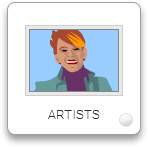Careers In Culture
Visual Arts and Crafts - What You Need to Do
Career Routes
On this page:
- Plan your visual career
- Jump-start your career
- Hands-on experience
- Your education can take you places
Plan your visual career
Building a career in visual arts, crafts or design requires creativity, an interest in all things visual, and curiosity about how to “get there from here.” You will need to explore how to get the information, education, training and experience that will enable you to achieve your career goals.
Depending on the choices you make, you could become a visual artist or administrator, a promoter or retailer, a teacher or critic. Your career could be in the fine arts, or one of the crafts professions. Or it could follow one of the many paths within design.

Jump-start your career
In pursuing a career in visual arts, crafts or design, you won't be alone. You'll find yourself working and sometimes competing with others who have aims and aspirations similar to yours. Here are some strategies for getting a jump-start on your career.
Be Knowledgeable
Want to be a visual artist?
Visit art museums, art exhibitions, art fairs and gallery openings. Check out books and magazines on art movements, art history and art techniques. Watch television programs about art and artists. Use the Internet to visit virtual galleries or connect with other artists nnd discussion groups.
Want to work in crafts?
Get ideas for crafts products and designs by visiting crafts fairs. Your provincial / territorial crafts council can give you when and where" information. Check out crafts galleries and shops. Read up on craftspeople and their techniques in books and magazines or at their websites.
Want a career in graphic design?
Cast a critical eye on print, advertising and online materials. Leam to distinguish between cutting edge and ho-hum design, between what's original and what's mere imitation. Interested in animation? See what's on television and on the Intemet, and go to animation festivals.
Looking for a managerial or retail job?
Visit and observe the operations of art galleries, artist-run centres, crafts galleries and retail stores. Try to get a co-op position at a new media company or a graphic design firm. Follow up business, technological and marketing trends in the fields that interest you.
Make Contact
Networking is a great way to connect with professional artists, craftspeople and designers. You can attend art exhibitions, art fairs, crafts shows, studio tours and open houses at art, crafts or design schools.
Make Contact
Be enthusiastic
People enjoy talking to someone at animation festivals who is genuinely interested in their work.
Be curious
Build your network faster by taking a genuine interest in others and being open to what they have to say.
Stay in touch
Like any other relationship, your professional contacts need to be kept up. Give the people in your network a call now and then, ask how they're doing, and tell them what you're up to.
Hone Your Computer Skills
No matter what kind of visual arts and crafts career you are interested in, computers have become an essential tool. Artists and craftspeople benefit from knowing how to use computerized accounting software to track their earnings and expenses. Nearly all careers in this discipline rely on the Internet – for example, e-mail, browsing, web design and e-commerce – to research, develop, market and promote products. Sophisticated electronic tools are essential in many aspects of this profession. Improve your employability by increasing your computer skills whenever you have a chance.
Hands-on experience
When you look for work in visual arts, crafts or design, employers will want to know what experience you've had. Don't forget: volunteer experience can be valuable too. Use the following checklist to see how you can get workplace knowledge and make useful contacts.
Career Routes
 |
If I'm a student, I could...
|
 |
If I'm an emerging artist, I could ...
|
 |
If I want to move into this work from another sector, I could...
|
Your education can take you places
Visual arts, crafts and design are each highly specialized fields with many branches. Pursuing your career goals means identifying which path interests you most, and which educational or training programs could put you on that path.
Education usually means enrolling in a university or college or Cégep program that leads to a degree or diploma in your chosen specialty. Specialized training can mean taking courses, workshops and seminars or participating in mentorships and apprenticeships that provide hands-on experience but don't usually lead to a degree or diploma.
Get the Right Education and Training
Research an institution.
The type of school and teachers you’re looking for depends on your interests. For example, if you want to major in art history, you’ll want professors who are well known in the field. If you want arts, crafts or design instruction, you need teachers who are working artists whose experience can guide you. If you are interested in computer art, consider an institution that offers a well-respected program in this field. And check out the art of the teachers or professors you are thinking of studying with to see if you are interested in learning aspects of their kind of artwork.
Visit the campus and the studios.
This is your opportunity to get a feel for how a school runs and the kind of art teaching you’d experience. Do you think you’d enjoy being a student there?
Talk to students and graduates.
Get first-hand information on programs and learn about different student experiences. The more people you talk to, the better chance you’ll have of making a good educational choice.
Learning Paths

- Animator
- Cartoonist
- Ceramist
- Classical animator
- Illustrator
- Installation artist
- Painter
- Photographer
- Printmaker
- Sculptor
- Studio artist
- Art director
- Book designer
- Computer animator
- Game designer
- Graphic designer
- Industrial designer
- Magazine designer
- Packaging designer
- Website designer
- Zine artist/publisher
- Blacksmith
- Bookbinder
- Glass worker
- Goldsmith/Silversmith
- Jewellery designer
- Leather worker
- One-of-a-kind book artist
- Paper artist
- Papermaker
- Potter
- Quilter
- Stained glass artist
- Stone carver
- Weaver Woodworker
- Art consultant
- Art gallery owner
- Art supplies dealer
- Craft show organizer
- Crafts dealer
- Crafts supplies dealer
- Creative director
- Framing shop owner
- Art gallery manager
- Artist-run centre manager
- Artists' / craftspeople's association director
- Communication company manager
- Crafts co-op manager
- Crafts fair/show organizer
- Crafts manufacturer
- Crafts salesperson
- Crafts store owner
- Art dealer
- Artist agent
- Artist-run centre administrator
- Fund-raiser
- Gallery administrator
- Grants officer
- Art critic
- Art historian / professor
- Art museum director
- Art preparatory
- Arts journalist
- Crafts museum director
- Curator
- Gallery administrator
- Gallery communication specialist
- Restorer
- Art school teacher
- College / CEGEP crafts instructor
- College / CEGEP design instructor
- Computer software instructor
- Graphic design instructor
- High school art teacher
- Visual arts professor
- Art framer
- Art installer
- Art shipper
- Gallery secretary
- Studio assistant
Since there's a good chance you will be working freelance at least some of the time during your visual arts career, you will have to take responsibility for your own learning and follow your own plan for upgrading your skills and knowledge.
Want to learn more about educational programs and schools? Talk to:
- A professional artist you admire in your community.
- Local arts schools.
- A teacher or career/guidance counsellor.
- A local librarian.
- Arts organizations in your community.
- The professional organizations listed on this website.